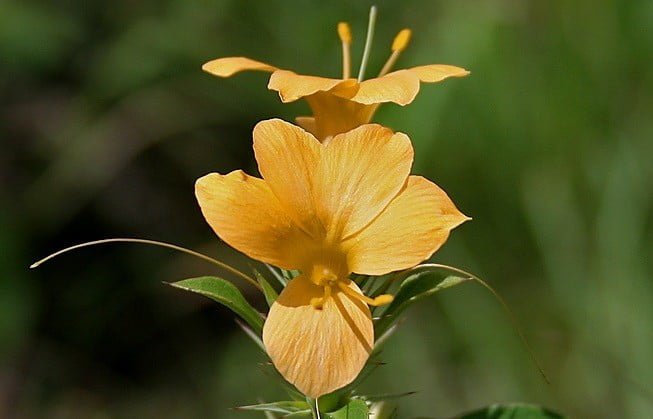Volumes have been written on the importance of flora as a panacea for saving this planet from doom. All across the world, humankind has been embarking on massive plantation drives for decades yet we are driving species to extinction at an alarming rate.
My red vented bulbul, Chitti, took off from my shoulder and flew into a gangeti (Grewia tenax) shrub. I watched closely as she instinctively gobbled up the stony fruit that she must’ve seen for the first time. A couple of years ago, my help—who comes from Rajasthan—saw me soaking some dry hingot (Balanites roxburghii) fruit in warm water. She told me that in her village they collected these fruit from the forest and used them as natural cleansers.
Just a few days ago, the lady who works in an adjacent building smiled at my terrace garden and said “aap khoob jadi booti ugaate ho” (You grow lots of medicinal plants). She said she is from Jharkhand and that she too collected these plants from the wild to treat ailments of various kinds. Most recently, I accidentally sent aloft a swarm of little insects while watering my barleria (Barleria prionitis) shrub.
I panicked when I recognized them as bees, but learnt that they are a relatively harmless species called Apis florea and when I looked closely I noticed that they built overnight, a tiny hive the size of a small baseball. I didn’t need much persuasion – they were welcome to stay, although I kept my distance. A hive that’s throbbing with thousands of bees just a couple of feet away and a few inches from ground demands your attention and respect.
Soon, I spotted other kinds of bees – blue banded bees and rock bees (Apis dorsata). I was captivated. My daily routine included observing them closely, as they didn’t seem to mind my presence. What surprised me is why they chose this particular thorny native shrub. They were using it for both food and shelter. As a passionate campaigner for planting native flora, incidents like the ones I’ve related reinforce my conviction of the important services plants provide not just for humans but for every little being, and how important it is for us to choose the right plants.
There is a plethora of research papers written by scientists on the inter-connectedness of flora and fauna for maintaining healthy ecosystems. Edward O. Wilson, the famous biologist, brings little creatures centre stage and entomologist Doug Tallamy makes a compelling case for bringing back native flora into our gardens to stop the conversion of this planet into fragmented deadscapes. Closer to home, Pradip Krishen, the author of Trees of Delhi and Jungle trees of Central India has kindled interest and inspired many to recognize, appreciate and grow native plants of Delhi NCR. I happen to be one of his converts.
Plantations are the issue?
Volumes have been written on the importance of flora as a panacea for saving this planet from doom. All across the world humankind has been embarking on massive plantation drives for decades yet we are driving species to extinction at an alarming rate – nearly 200 species every day, as per a UNEP report. So where are we going wrong? And why?
The most prominent reason undoubtedly is our total disconnect from wilderness, and this in turn springs from diminishing dependency on native flora. Humans now buy products off the shelf that are produced in polluting factories, and traditional knowledge of recognizing wild plants as a source of medicine, food or clothing is becoming redundant. This has led to devastation of fertile areas rich in biodiversity; native flora, especially understory herbs and shrubs are cleared in plantation drives, to be replaced by exotics and ornamentals.
It is widely acknowledged and accepted that the obvious outcome of industrialization and urbanization is the destruction of forests. The fact that shortsighted greening programmes can wreak more havoc than do good to our living landscapes is not recognized as an issue. The species that go into plantations change like fashion trends. Trees are chosen based on the ease of their availability in nurseries. Fast-growing, easily maintained ones are hot favorites. Shrubs, grasses, herbs, climbers don’t make it to the list, and even when they do, they are usually the wrong ones.
Imagine you are offered a glass of sea water to drink. Would you quench your thirst with it? It IS water, but is not potable. Growing inappropriate plants that are not edible does the same thing to the insects which play a key role in the food web. It is easy to uphold the large visible creatures as mascots of conservation, but we miss the little ones, like bees, beetles, moths, ants, butterflies, dragonflies, spiders and more. They may be insignificant in size but they are the greatest pollinators and energy-exchangers of the biosphere without whom our food web will collapse.
If we don’t plant specific native flora that insects have co-evolved with for millions of years, we will lose not just these insects, we will also drag to their doom other beings hinged to them. Here I wish to mention the oft-stated example in our nature lovers’ circles to the relation between the fig and the wasp, how every fig tree has a specific wasp that pollinates it. No wasp, no fig!
How to set things right?
So how do we retrace our steps to start getting things right again? Plant we must, planting right is how we correct it. Re-establish the severed connection with nature through field trips for regaining the lost wisdom on jungli pauda so that they are not wiped out due to our blindness in recognizing their worth, in our zeal to plant a million, is where we begin.
If villagers stop teaching the next generation to identify wild plants like jhar beri (Ziziphus nummularia) eaten during Navratra or the jaal fruit (Salvodora oleoides) cooked in porridge, we will lose touch with nature’s pharmacy derived from wild plants, which is just a few of the zillion uses they have for humans and animals. It’s absurd to clear an already thriving functional ecosystem of forest flora and planting misfits due to our inability to identify what they are.
Large-scale outdoor awareness activities that teach the identification of native species must be an integral part of all educational institutions, especially for horticulture and landscape students. As for imbibing this nature-connect in children, the earlier it happens the better.
Next is growing them, that’s what plantation drives should be all about. There is currently a paucity of nurseries that stock native species. Obviously there are no takers, because it’s a catch 22 situation. This trend is changing gradually, with more and more people embracing the idea of planting native flora in their gardens. We may not plant up every inch with native plants but every garden must carve out spaces for them so that we can all have bees in our barlerias.
This article was first published on Sunday Guardian Live.


